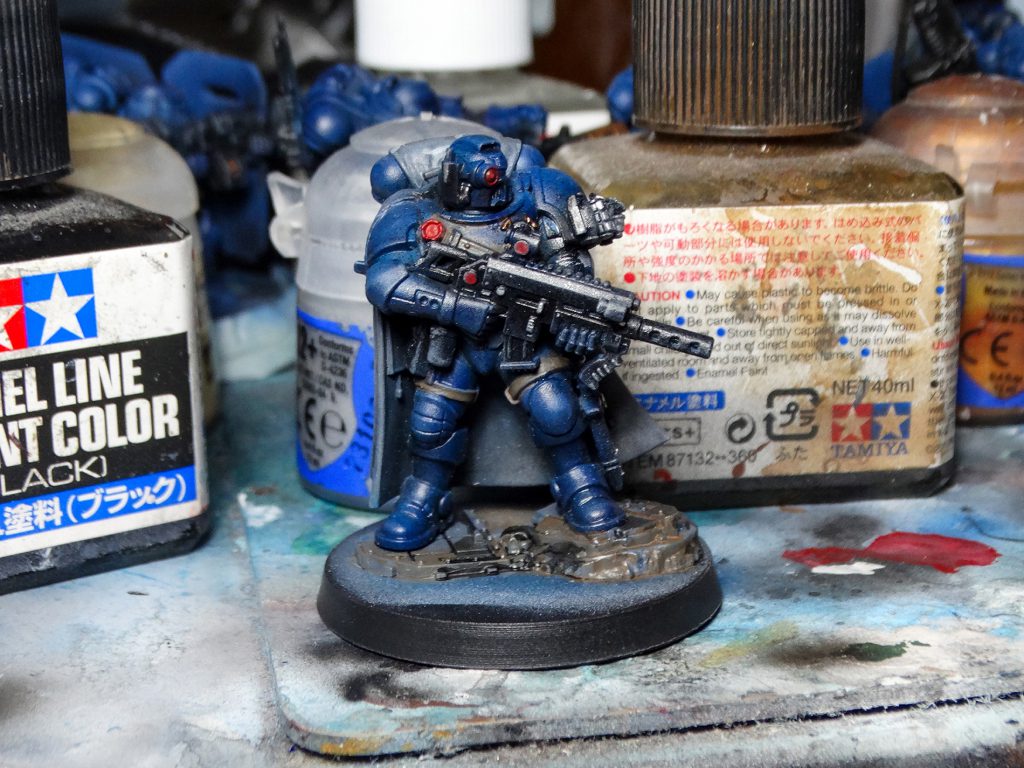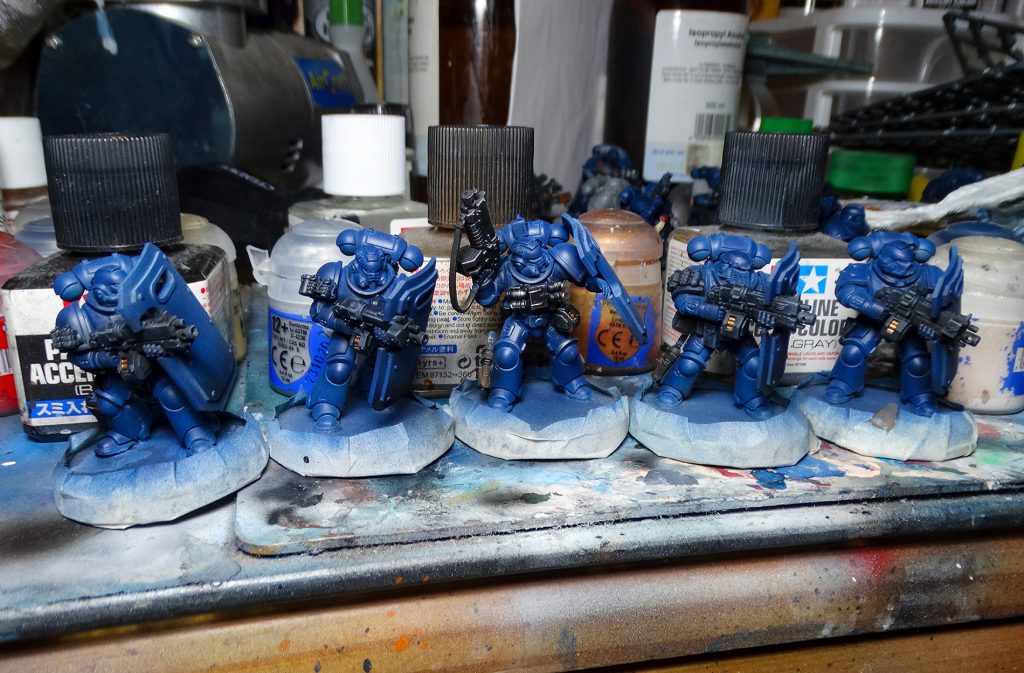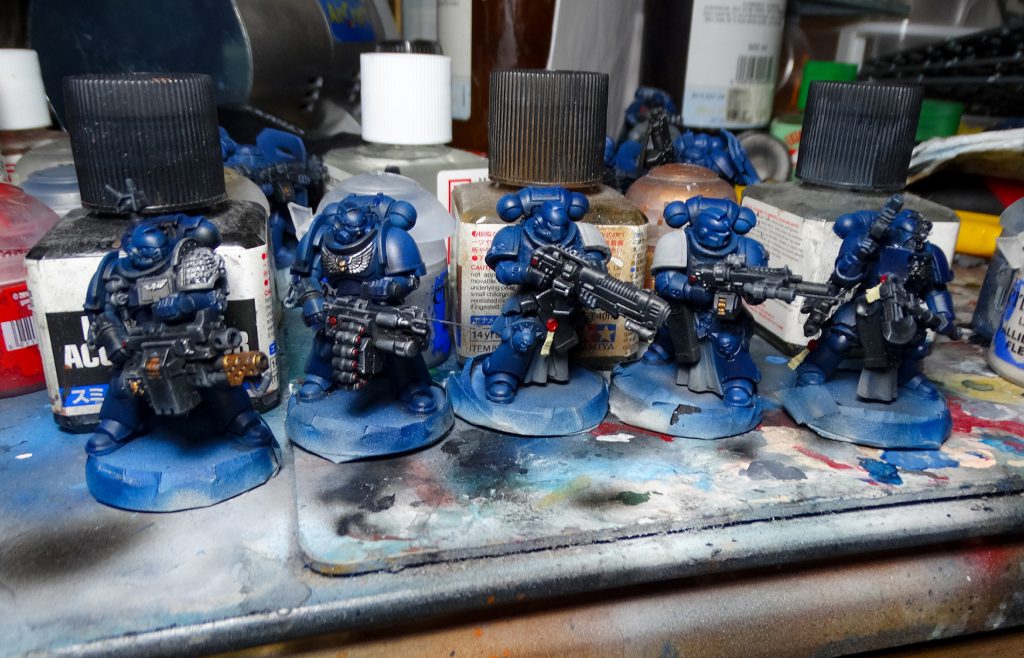Goonhammer’s Boarding Patrol Challenge is ongoing and it ends at the end of the month. By now, you’ll hopefully have a cohesive idea of what your patrol consists of, and seen your modelmaking ideas blossom into reality. That or you’ve been shocked into the existence of this little event and are clawing together info. Either way is fine – the point is to get a boarding patrol onto the table.
Hello ladies, gents, theys, and gays. Summer’s back with another bit on Boarding Patrols. This time, I want to talk about painting, and the reflective processes behind it. Most people who build and paint miniatures discover that they prefer one or the other. This isn’t surprising. Although both steps have to be completed to reach a complete model, building and painting use very different skillsets and techniques. It’s possible to be a hobbyist without touching one of those sides. Some people are involved in the commission painting process (as painters or buyers), and others avoid building through commissioned sculpting and 3D printing.
I have a preference too – I enjoy converting and building far more than painting. I find that there are fewer ways for building to go wrong, and I have what is functionally a ctrl-z key by prying bits apart before the plastic cement sets. I exercise my creativity by shaping a model, but painting can frustrate me because I don’t have as clear an idea of where it will end up. Likewise, I’m fully on board with people who find scraping the casting gates and lines away to be an exercise in frustration, an just want to get their brushes out to bring an idea to life.
So I know how you feel, and I’m not here to make people feel shitty about preferring to paint, built, or neither. But this is a Painting Challenge so I’m going to discuss Painting. Not the act, but the stuff behind the curtain. If you came here to learn how Summer paints the very specific shade of blue on her very specific homebrew chapter, then just ask in the comments and I’ll probably show up. I want to write about something that resonates more with the struggling hobbyist and artist in each of us.
I want to write about mindsets.
The title was a trap.

Painting Your Boarding Patrol
If you know me, then you’ll know about my gleeful and ambitious dives into my bits box. Building models brings me the same joy as being a child experimenting with Lego (gods, when did Lego become a luxury good…). When I finish building a miniature, I proud of myself for deviating from the assembly guide and creating something that is truly unique. Even if it never gets painted, I’ve built a thing that is unlike any other on Earth.
This is also how they end up languishing on my to-do shelf. Painting takes substantially more time to me, and I can never be sure if an idea is working until late in the process. If you’re a reluctant painter or builder like me, I think there’s some psychosocial stuff that we can talk about.
Reflection
Art is a personal process that leverages the best of our mental and physical capacities. Society tends to infantilize participation in the arts in adulthood if you’re not doing it for a ‘valid’ reason like profit or fame. As adults, we often lose the joy of creativity and trade it for more grown-up motivations like improvement and profit. Our motivations and mindsets change – sometimes for the worse.
That’s why creating art should be an open and reflective process. A reflective process in which you examine your interests, needs, and biases to improve your approach. Reflection brings us to the core of how and why we do things in a certain manner, rather than techniques and tools. I firmly believe that the best asset to an art project is a motivated and enthusiastic artist – techniques, tools, ‘talent’, and knowledge are secondary.
Let me take you by the hand through a simplified process of reflection in the context of our delightful hobby. I’ll set the boring flow charts and concepts from my Master’s in Psychology aside, and just talk practical stuff. Wargamers love our practicality, after all.
Facts
The first layer of reflective questioning is fact-finding: Why do I participate in ‘the hobby’? What drives me to finish a project? What steps do I divide the process into? What are my hobby habits?
These are things that can be put down in bullet points or short lists. Some of them are surface-level considerations that we think about in every project. Other questions here might be foreign to you. Either way, reflection starts with stepping back and looking in, rather than looking out from the inside. This first layer switches us from the viewpoint of experiencing the world as a participant, to examining ourselves as an observer – as best as we can. Cultivating that third-person perspective is vital for any reflection.
When I began the fact-finding on my process, I wasn’t happy about the outcome. I realized that I make more hobby progress when I get the mental boost from Instagram validation. I’ve shifted my mindset toward something that is goal-oriented, and the goal is a finished product that photographs nicely for my social media like Reddit. I’ve even divided my hobbying process into Build, Paint, and Photograph sections that are wholly separate and documented for social media. It was evident to me that I’ve traded some of the joy of making art for the joy of social participation.
Your answers may be different. They may surprise, or disappoint you. Which is good – surprise and disappointment are the foundation of the next layer.
Feelings
The second layer of reflective questioning is emotive: How does my hobby process make me feel? Which parts make me happiest? What steps do I dread? When my hobby goes ‘public’ to others, how do they react? How does that make me feel? Why does any of this make me feel this way?
Humans are emotional creatures, and no amount of suppression or caterwauling about logic and resilience will change that. We are always experiencing an emotional something and those feelings matter a LOT to understanding ourselves and our state. Even total apathy or detachment is a feeling, and there’s a source and a meaning behind that feeling.
Questioning the emotive aspect of our hobby participation serves two main purposes:
1. It reminds us of our humanity as artists.
It can jolt people out of detachment and remind them of the joy they feel (or used to feel…) when painting their favorite faction. It makes people aware that ‘the hobby’ isn’t a one-way process where you extract joy from plastic via an investment of time and money. Our engagement with miniature hobbies is cyclical. It affects us emotionally, and our emotions affect it. We’re participants, not instigators.
2. It lays a comprehensive foundation for improvement.
Examining the emotional aspect of our hobby engagement after developing a ‘factual’ account gives us more information to work with. Too much facts without feeling leads to nonviable answers. Too much feeling without facts leads to uncertainty and despair. Having both on hand anchors your reality to your well-being, and gives your reality space to breathe. It helps you develop a personalized path to the future. Your answer only works for you, and is sensitive to your context, process, and well-being.
So back to me.
As a simplified example following on from the fact-finding exercise: I reflected on the particulars of my situation and how they made me feel. For one, I felt bad when I realized that much of my hobby is mediated by the opinions, input, and participation of others. I was always schooled to be an independent person who doesn’t care what others think, and my behaviors betrayed that (admittedly absurd) principle. Likewise, a bit of societal bias against women on social media has slipped in too: it made me feel bad to think of myself as part of the same crowd as those frivolous ‘Insta-queens’ when I am not like that. So I filed that thought away for later processing.
Most importantly, my enjoyment of this hobby has been negatively impacted by the logistical burden of maintaining a social media presence. Photographing and making posts is distracting. It breaks up my workflow. I fixate on the desire to photograph and schedule my complete project, rather than participate in the glee of being creative. I’m fixated on completing my projects as a series of demarcated steps that meet a non-artistic goal, rather than being happy. I’m sure many Goonhammer team members and people who have a foot in the social media and journalism side of the hobby can empathize with this.
On a meta level, reflecting on this made me emotional. I felt annoyed that I was forcing myself to confront the predictable outcome of my own actions. I was disappointed in myself for ‘letting myself slide’ like this. That statement is very telling of how I approach life – I’m a tightly wound person who cherishes control, but I also deride myself for ‘failures’ to ‘control myself’. There’s a lot more tied to our hobby participation that modelmaking or painting. There are social elements; our self-esteem feeds into it; it can be an anchor for our well-being, or a sticking point for our bad moments.
It’s not all bad, though. Few things ever are. I felt pride that my efforts to build an online presence have found success. My wargaming interest got me started at Goonhammer, which launched my lovely gig as a freelance writer. I was mirthful when I realized that a couple years ago, I was doing far worse on social media and wouldn’t be reflecting at all. Lastly, I was determined to write this article because I had something to talk about.
Reflection is seldom an easy process. It’s about stepping into your insecurities and fears enough to examine them, but not becoming a casualty of your own exploration. The rule of thumb for reflection is that if it’s coming very easily, then there’s a good chance that you’re missing or denying something.

Crystallize
Reflection in the absence of action is just idle navel-gazing. That kind of thing leads to angst, despair, or misplaced confidence. Reflection should be a process we use to do something better or appreciate what we’re doing right. It should serve us.
So the third step in this highly simplified reflective process is to turn the information you’ve gathered into something useful. I avoid the word ‘solution’, because ‘solution’ implies the existence of a fix that can resolve these problems. There are no solutions to mental well-being – ever. There are processes, efforts and missteps. If it were easy, we’d have done it by now.
Some people reflect by drawing diagrams or journaling. Others (such as myself) do so by sitting down and grinding our brain cells together until we produce a ‘thought’. Friction and determination will suffice where pen and paper fails.
What you’re doing here is identifying areas of improvement and mapping out the roads down those paths. I’m one of the obnoxious peoples schooled in positive psychology, which means I don’t speak in terms of deficiencies or failures. I talk about Areas of Improvement™. We’re looking to go up and appreciate our accomplishments without beating ourselves up.
So based on your impressions of your hobby, you question yourself again. Are my negative feelings connected to my process? In what ways do the perceptions of people around me impact my hobby enjoyment? What positive aspects of my workflow can I build on? What small adjustments can I make to improve my life right now?
The hardest part with these answers, as with any other step in reflection is to be non-judgmental and open to yourself. Nobody is evaluating your reflections but yourself, but we’re often our own worst critics. If you find a truth in your answers, it’s good to sit with it, rather than discard it. You might even arrive at a disconcerting answer like, “I don’t even enjoy this hobby anymore, and want a break.” If that’s the outcome, sit with it. Sit – not wallow. Many hobbyists have reached that exact conclusion. If you’re part of the social side of the hobby, you’ll know of someone who came to the decision to pause. What matters is that you arrived at an answer for you, by you.
I for one am sticking around, but my reflective process from this project has showed me a few… areas of improvement.
Namely that I should find a better balance between the fun aspect of my hobby and its social media side. I should perhaps reconsider the importance of socially-mediated opinions of my work, and focus on the enjoyment of it. I want to make each step a bit more enjoyable and precious, rather than fixating on the results. Or worse,fixating on Instagram likes.
Maybe the best thing for me is to approach my projects with a desire to learn, rather than a desire to succeed.

Okay, Summer. What about Your Boarding Patrol?
You’re still here?
Well, since we last talked, I’m underway with painting. The Lieutenant is getting to a good place, the Intercessors and Sternguard have a good basecoat, and my Eradicators just got their first layers of paint (shades of blue, grey, and black). It’s a nice little assembly line where I work on one unit at a time, and switch as necessary. My favorite part of this Boarding Patrol endeavor is that I can work on an array of models, so I never get bored of painting a single squad.
The most significant deviation from my old style of painting is that I’ve switched from Citadel Air to Tamiya for my main blue. Citadel Air’s formula is absolutely dreadful, but I was a loyalist. After much emotional build-up, I cut my losses (with three unopened bottles of Citadel Air Kantor Blue) and tried a Tamiya Royal Blue. It sprays better.
I have a very… rushed and personally developed style of painting that involves airbrush, shortcuts, and weathering. I aim to create models that are moody and worn, rather than eye-catching. My favorite colors are shades of black and grey, and my style reflects this.
Due to warehousing and shipping delays, my Phobos Strike Team still hasn’t arrived. This is a source of anxiety, since that’s a whole unit that might have to be built and painted very quickly, which breaks my process. In the worst-case scenario, I’ll unhappily substitute some existing Infiltrators I have for the photos and build the Cool Guys. Ah well.
Anyway, Summer out for now. I’ve got painting and Rimworld to take care of. Y’all have a good one.

Have any questions or feedback? Drop us a note in the comments below or email us at contact@goonhammer.com.


